#water treatment
Link
“The team created a composite of boron nitride and titanium dioxide and discovered that they had a substance with the best of both worlds. It was activated by the UV light in the atmosphere and it was capable of destroying PFOA very quickly. In deionized water, it took less than three hours to break down 99 percent of the PFOA into carbon dioxide, fluorine, and minerals. In salty water, the process takes about nine hours.
The team will now investigate how good this substance is at breaking down other perfluoroalkyl and polyfluoroalkyl substances (PFAS) – the broader class of forever chemicals.”
There’s been a lot in the news about PFAS lately--there is tremendous effort being put into addressing this issue and, while faster would be better, progress is being made.
#pfas#water pollution#plastic pollution#chemicals#forever chemicals#water treatment#science#technology#environment#good news
3K notes
·
View notes
Text
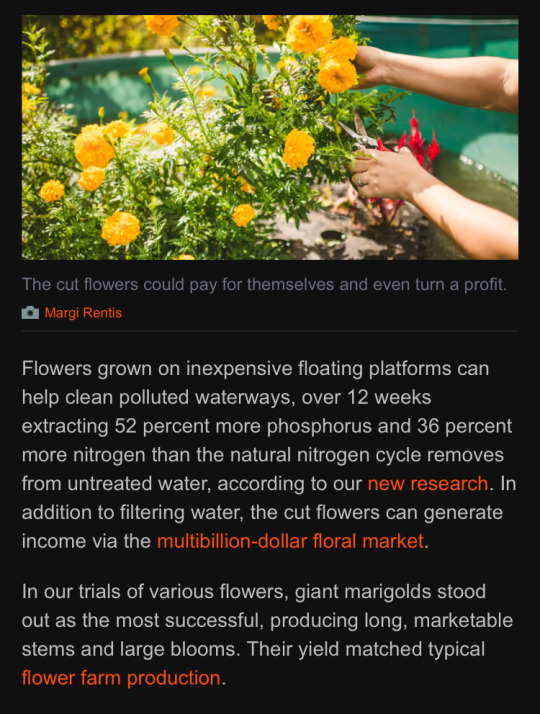
#good news#this is so cool because this is a HUGE issue#algea blooms and dead zones…..but this and maybe other similar solutions#environmentalism#science#environment#nature#flowers#flora#floating farms#waste water treatment#water treatment#clean water#water pollution
70 notes
·
View notes
Text
I'm going on a tour of a water treatment plant today. Yay, paid field trip!
#off topic#water treatment#field trip#work stuff#at work#touring the facility#and picking up slack? lol#mar 22 2024
28 notes
·
View notes
Text
From beach blight to bio-brilliance: Mexican researchers transform sargassum seaweed into sustainable paper, filters, and water treatment systems, saving the Caribbean's biodiversity.
28 notes
·
View notes
Link
51 notes
·
View notes
Text
Norovirus on the PCT . . . How an outbreak spreads along the trail
September 24
By Pien Huang for NPR
I was just corresponding with another PCT-hiking friend about the few times we have felt unsafe on the trail. All of our examples related, not to bears or rattlesnakes or even lightning (I might have included lightning had I thought about it more), to human encounters. A lost soul or two on the trail, hunters combining alcohol and firearms, a camping area near a road. Now here is another thing to worry about . . . norovirus. It is a good reminder not to abandon hygiene in the wilderness. RH

EIS officer Arran Hamlet walks into the Government Meadows site to conduct environmental sampling for norovirus.
Last September, Kevin Quinn was trekking through a remote, mountainous region in central Washington state, when he started feeling sick. "At first, I thought it was just a stomachache," he says, "But when we got to the campsite I started throwing up, and it started coming out the other end as well."
Quinn was on the trail with his daughter, who had left her job so they could hike together. After months of hiking, he found himself wiped out at a campsite in the middle of nowhere.
"I had heard about the norovirus for years, but it was always in the context of 'Oh, there's a cruise ship in the Caribbean,'" he says, "You don't think about this being an issue when you're out on the Pacific Crest Trail."
Norovirus is a highly contagious virus that can cause serious gastrointestinal distress for several days. It's often associated with enclosed, crowded settings like cruise ships, health care facilities and childcare centers.
But it also crops up in the wilderness – like in an outbreak among hikers like Quinn last year which was documented in a recent investigation by the Centers for Disease Control and Prevention.
Call in the disease detectives
After a stream of sick Pacific Crest Trail hikers came through the Washington Alpine Club Lodge near Snoqualmie Pass last summer, a volunteer named Robert Henry closed the dorm-style lodge and emailed health authorities.
"My concern at the time was to make sure that the hikers on the trail didn't get any worse, and to make sure that the volunteers at the Washington Alpine Club didn't contract whatever it was they were bringing in," Henry ways. He also worked to warn other hikers about the threat.

EIS officer Dr. Arran Hamlet observes a water source being tested for environmental contamination of fecal waste and norovirus.
Hamlet focused on a 70-mile stretch of trail south of the Lodge, where ill hikers were coming from. One common rest stop, he learned, was a remote log cabin in the meadows, with a pit latrine and a stream that's used for drinking water.
Hamlet and his team hiked out to the cabin and tested water from the stream. They also swabbed the toilets, the door handles, the tabletops, the poker chips – anything people were touching. While the water samples came back clean, "every single [surface] swab tested positive for fecal contamination," he says.
"This doesn't mean that we can see human feces on things," he adds, "but at some point in time, there was transmission of human fecal contamination onto every surface in the cabin we swabbed, and also everywhere in the latrine."
The results of the investigation were published this month in the CDC's Morbidity and Mortality Weekly Report. Investigators concluded that there was an outbreak of norovirus on the trail last summer that was spreading between hikers and that "exposure to contaminated surfaces within the cabin and ... latrines likely amplified transmission."
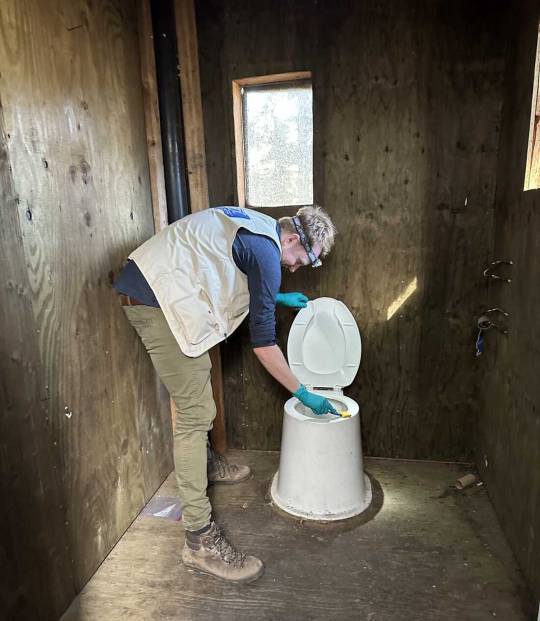
EIS officer Dr. Arran Hamlet swabs a backcountry pit latrine for norovirus sampling during an investigation for an outbreak of gastrointestinal illness among Pacific Crest Trail Hikers in 2022.
Shanna Miko, a nurse epidemiologist at CDC, was part of the field team on the Pacific Crest Trail study — and it wasn't her first norovirus-in-the-woods investigation. Last year, she traced an outbreak at the Grand Canyon, among people who were backcountry hiking and whitewater rafting.
"These are very well-planned trips. For many people, they're once-in-a-lifetime," she says. Travelers often read books and blogs in preparation, and get advice from others who have done the trip before them, accumulating trail wisdom – "places where people frequently stop, or places that have shelters where people frequently sleep over," good places to get water, or use the bathroom, she says.
These hubs, which seem so remote, see thousands of people – in varying levels of wellness – pass through in a season. They may not leave visible traces but some may leave germs, like norovirus, that can live on environmental surfaces for a long time, Miko says. (According to the CDC, this hardy virus can stay alive on surfaces for "days or weeks.")
Hand sanitizer doesn't cut and other advice for staying well
With norovirus, hand sanitizer and common water filters don't work. The virus is small, and "extra sticky" on skin, Miko says. And it takes just a few dozen viral particles to make a person very ill.
Miko says there are ways that hikers can cut their risks.
Always wash your hands with soap and water after you have a bowel movement – and wash them again before you eat. "The soap is a great detergent to remove the virus from your hands," she says. While any soap and water will work, she recommends biodegradable soaps in protected national parks and backcountry woods to reduce the impact on the environment.
Make sure to drink and cook with good, clean water. Pay attention to where the water comes from, and treat it properly. "Boiling for at least three minutes is the best way to kill everything you would typically come across," Miko says. And note: Most water filters are good at removing bacteria and common parasites but they don't cut it when it comes to norovirus. You'll need to layer on either chemical treatment or UV light treatment to kill the virus. (Here's the CDC's breakdown of what works for which pathogens.)
If you do fall ill, shelter in place if you can. This is for your own safety, and for the sake of others, "so you aren't seeding norovirus particles along the trail and putting others at risk," Miko says. This is not the time to try to push ahead but to rest and hydrate. "If possible, try to keep your defecation far from the trail and bury it, and don't prepare food anywhere near where you're using the restroom or vomiting," she says.
The worst of the symptoms usually passes in two to three days, though "you can still spread norovirus after you feel better," Miko says. She recommends waiting at least two days after symptoms have resolved before continuing on.
Norovirus was the last straw

Kevin Quinn set out to hike the Pacific Crest Trail with his daughter, Katie, who had left her job so they could hike together. Norovirus derailed their plans.
He was thirsty, he was really tired – and while he filtered the water, he skipped the additional, chemical treatment. Soon, he knew he'd made a mistake. "I was completely debilitated. I didn't have the energy to set my tent up," he recalls, "All I was doing was, like, every 15 minutes, going off into the woods and either throwing up or having diarrhea."
After a night of being very ill, Quinn and his daughter made a long, slow trek out of the woods. "We never made the whole trail," he says, "We just decided to call it quits."
Earlier in the summer, he caught COVID, which derailed his trail plans for a month. Up ahead, there were wildfires and trail closures. For Quinn, getting norovirus was the last straw.
A year later, he still regrets that he didn't take the time to treat the water properly.
To other hikers – he says: heed the signs, wash your hands and make sure your water is clean. In his experience, it's not worth the risk.
And, we would add, that water treatment options like the Steripen (using UV technology), would seem to be more effective.
9 notes
·
View notes
Text
What Is an Industrial Water Treatment System and How Does It Work?
Water is the lifeblood of countless industrial processes. But unlike the kind that comes out of your tap, industrial water often needs a little extra TLC before it's ready for action. That's where industrial water treatment systems come in. At PureBact, we understand the importance of clean, reliable water for your facility's operations.
Here's a breakdown of what industrial water treatment systems are and how they work:
What is an Industrial Water Treatment System?
An industrial water treatment system is a customized set of processes designed to remove impurities and adjust the properties of water to make it suitable for a specific industrial application. This could involve anything from making boiler feed water ultra-pure to treating wastewater before it's released back into the environment.
Why is Industrial Water Treatment Important?
Untreated water can wreak havoc on your industrial processes. Minerals can cause scaling and corrosion in pipes and equipment, while contaminants can affect product quality. Proper water treatment helps to:
Protect equipment: By removing impurities that can cause corrosion and scaling, you can extend the lifespan of your valuable machinery.
Ensure product quality: Consistent water quality is essential for producing consistent, high-quality products.
Minimize environmental impact: Industrial wastewater treatment helps to remove pollutants before they are released back into the environment.
Reduce operating costs: By preventing equipment damage and ensuring efficient operation, proper water treatment can save you money in the long run.
How Does Industrial Water Treatment Work?
The specific treatment processes used will vary depending on the source water and the desired end product. However, some common methods include:
Pre-treatment: This stage removes large particles such as sand, debris, and organic matter through filtration or sedimentation.
Clarification: Coagulation and flocculation techniques help suspended solids clump together and settle out of the water.
Filtration: Various filtration technologies, like sand filters or membrane filters, remove finer particles and contaminants.
Ion exchange: This process removes unwanted ions by exchanging them for harmless ones.
Deionization: A specialized form of ion exchange that removes both positively and negatively charged ions to create high-purity water.
Disinfection: Chemicals like chlorine or ultraviolet light can be used to kill bacteria and other microorganisms.
PureBact: Your Partner in Industrial Water Treatment
At PureBact, we offer a comprehensive range of industrial water treatment solutions. Our team of experts will work with you to assess your specific needs and design a custom system that ensures optimal water quality for your operations.
Contact PureBact today to learn more about how we can help your business thrive with clean, reliable industrial water.
2 notes
·
View notes
Text
On Thursday, the newly reopened House passed H.R. 4394, Energy and Water Appropriations. The bill will go through major changes on arrival in the Senate as it attempted to gut all of the environmental regulations and spending put into effect by the Biden Administration.
#H.R. 4394#Energy and Water#Appropriations#energy conservation#energy exploration#water treatment#climate change#u.s. house of representatives#house of representatives#roll call#FY2024#to the Senate#21 days left#government shutdown?#right wing wet dream
3 notes
·
View notes
Text
https://www.advanceequipment.in/effluent-treatment-plant-manufacturer-supplier-in-punjab-india.php
#sewage treatment plant#water treatment plant#sewage treatment plant process#water treatment#sewage treatment#sewage treatment plant on ships#wastewater treatment#sewage treatment process#sewage treatment plants#marine sewage treatment plant#sewerage treatment plant#wastewater treatment plant#sewage treatment plant animation#sewage treatment plant working model#effluent treatment plant#marine sewage treatment plant working principle#treatment process
3 notes
·
View notes
Text
Bạn nên chọn bộ lọc sinh hoạt như thế nào? Một số tiêu chí đánh giá bộ lọc nước- Sài Gòn Xanh
Các tiêu chí này được lập dựa trên kinh nghiệm thi công và các thắc mắc mà khách hàng hay hỏi Xử lý nước Sài Gòn Xanh trong quá trình tìm hiểu sản phẩm. Có tất cả 6 tiêu chí:
1. Độ bền sản phẩm:
2. Áp lực nước sau lọc/ áp lực súc xả:
3. Kết cấu hệ thống:
4. Thao tác vận hành súc xả:
5. Thay nguyên liệu/chi phí vận hành:
6. Chi phí lắp đặt:
XỬ LÝ NƯỚC SÀI GÒN XANH - VÌ SỨC KHỎE CỘNG ĐỒNG!
TƯ VẤN - KHẢO SÁT - THI CÔNG.
0976 123450 - 0933 60 22 44
https://sgx.com.vn/blogs/news/bo-loc-sinh-hoat

3 notes
·
View notes
Text
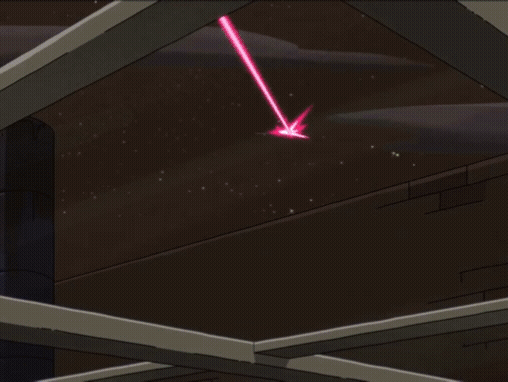
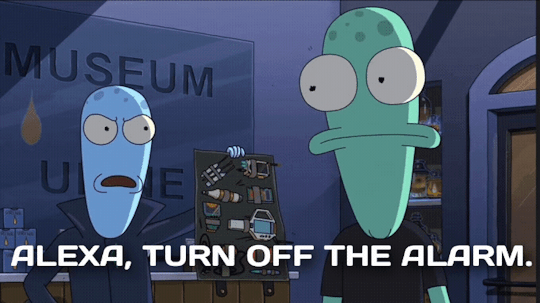

#solar opposites#gif#gifs#gifset#korvo#korvo opposites#terry#terry opposites#102#solar opposites season 1#heist#break in#water treatment plant#water treatment#museum of urine#laser#tractor beam#levitation#theivery#theft#sneak#spy#ski mask#mission impossible#alexa#alarm#jealousy#jealous#gift shop#glass ceiling
19 notes
·
View notes
Photo

A rainwater harvesting system collects and filters rainwater so that it may be utilised for a number of purposes.
3 notes
·
View notes
Text
How one neighborhood in Colombia is tackling climate change at the community level https://one.npr.org/i/1228839451:1228839452
In Colombia's second-largest city, rainy season floods and dry season fires are now a fact of life. As reporter Jorge Valencia found, local residents are grappling with those and other effects of climate change by taking matters into their own hands.
#climate change#climate solutions#columbia#community organizing#clean water#water treatment#dignity#good news#science#environmentalism#grassroots movements#indigenous people#community activism
13 notes
·
View notes
Text
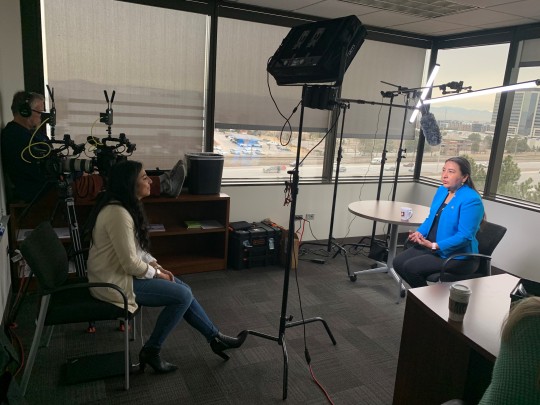
Dear Gus & Magnus,
I spent the day doing interviews with our Denver Water Team staff to help them expand the brand in Colorado. The best story: One of our engineers grew up in Juarez/El Paso with brown water coming out of the sink. Her mother used to tell her to let the water run for a while before drinking it because they weren't sure if it was safe. That little girl grew up, boarded a Greyhound bus, and put herself through school in Colorado, where she learned how to treat water. Now she's working to provide clean water to communities all over the Southwest. It's a powerful story that I'm glad I get to tell.
Because Yuliana is a native Spanish speaker, we decided to also interview her in Spanish. I took two years of Spanish in high school, three semesters in college, and Nene used to make us listen to Spanish lesson cassette tapes in her minivan when I was kid, but I still can't speak the language, so I had Sasha come in to run the interviews.
Dad.
Greenwood Village, Colorado. 3.1.2023 - 10.22am.
#bryan stafford#sasha cerrato#yuliana porres-mendoza#interview#work#film crew#water#water engineering#water treatment#juliana porras-mendoza
6 notes
·
View notes
Text
Summary
Four compounds—caffeine, nicotine, acetaminophen and cotinine (a chemical produced by the body after exposure to nicotine)—showed up on every continent, including Antarctica
Another 14, including antihistamines, antidepressants and an antibiotic, were traced on all continents except Antarctica.
Many of the most heavily-polluted rivers are in Asia and Africa, possibly because access to medicines have improved, but water treatment infrastructure are still developing
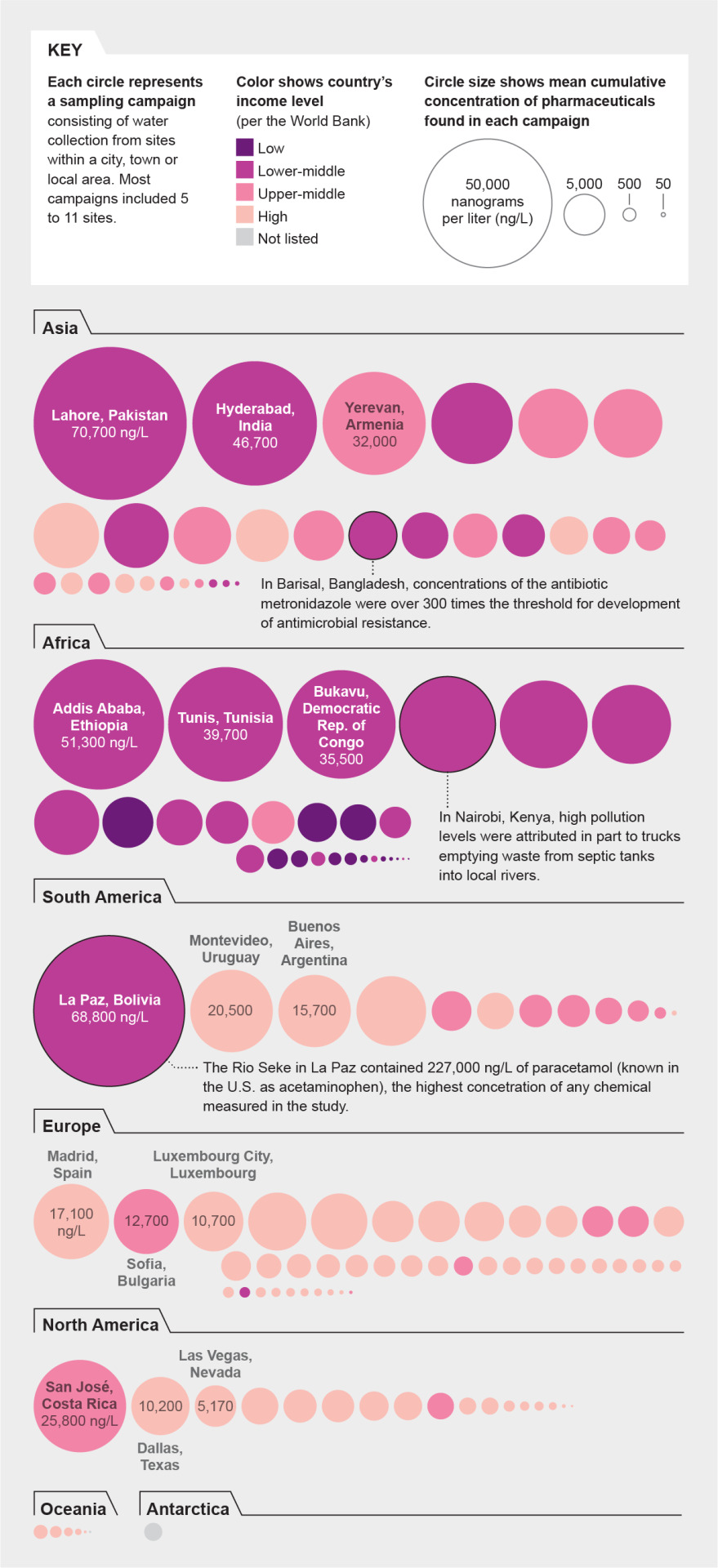
#aslzoology#asl zoology#zoology articles#social science#sociology#anthropology#studyblr#studyspo#study#news#drugs#medication#medicine#pharmacy#water#wastewater management#water treatment#equality#inequality#feminism#social equity
11 notes
·
View notes
Text
U.S. Water and Wastewater Treatment Technologies Market by Treatment Technologies Type (Membrane Separation & Filtration, Sludge Management Technology, Activated Sludge, Clarification) and Application - Forecasts to 2029
#U.S. Water and Wastewater Treatment Technologies Market#Water and Wastewater Treatment Market#water treatment#wastewater treatment#environment
2 notes
·
View notes